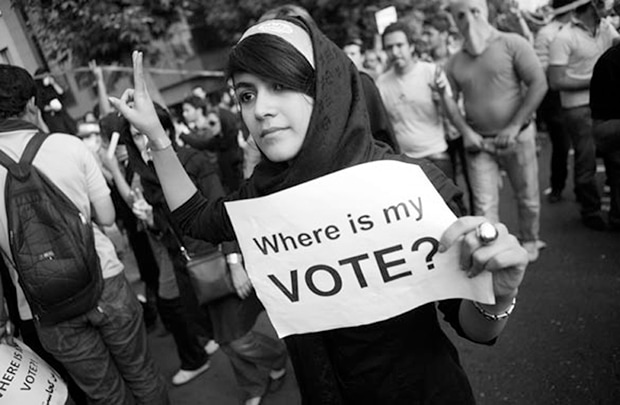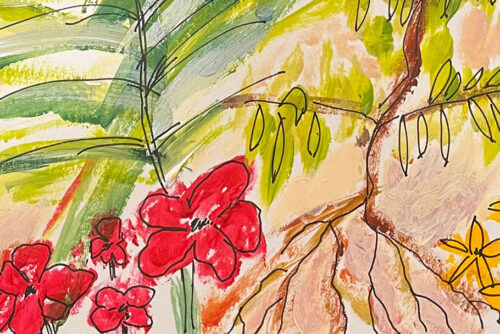We are certain to notice uniformity in the coiffure and dress of the 1950s and 1970s photographs, but given the government-enforced veiling of women, the uniformity in dress in the 2009 photographs is bound to feel very different. Rather than the fashion-catalog-sameness of the outfits in the 1950s photograph, in the 2009 photographs, the young women especially, show a desire to alter a given uniform. The state-enforced Islamic uniform—the hijab—playfully reveals strands of hair. Women don headbands and colored headscarves to voice their desire for change (Figure 4).

The photographs that went viral on social media during the course of the 2009 Iranian uprising, in particular, capture the multigenerational presence of women, again, shoulder to shoulder with men. We often think of the public sphere in the Islamic Republic, a state run by a firm-handed theocracy for thirty-odd years, as a largely male, homosocial sphere. Yet, the camera insists in nearly every shot on capturing the heterosociality of this sphere, just as it did in earlier moments of Iranian history. Rather than emphasizing the secularism of the movement that demanded civil and human rights in Iran, or the middle-class and urban character of the resistance, the combination and juxtaposition of the photographs of the period highlight two key terms: the heterosociality and the corporality of the protest in public space in 2009. This becomes evident in a close reading of Figure 5.

In her questions to me, Golbarg Bashi pointed to the sense of “properness” that is alive in the “pretty” floral dresses that the women are wearing, as they sport their “nice sunglasses” in the 1953 photograph (Figure 1). This image dissolves for me into the stalwart posture of a young woman about to throw a stone in this 2009 photograph (Figure 5). In the latter image, we are witness to an undeniable element of a corporal confrontation, “a coming face-to-face” with police and security forces in public spaces where by virtue of the positioning of the camera alongside the protestors, our own corporality is implicated in the alignment of our look with its look. This kind of alignment is largely absent in the photographs of earlier periods. Indeed one could say that a certain corporality is deemphasized by the “objective” distance of the camera and by the sartorial choices that either situate themselves within the flows of commercial capital and global fashion or that squarely take a stand against the same by virtue of the chador in the 1953 photograph.

The corporality of the 2009 photographs strikes me as allegorical by contrast. While we must be vigilant in remembering the presence of young women in such militant guerrilla movements as Cherikha-ye Fada’i Khalaq or Mujahedyn-e Khalq in the 1970s and 1980s, as Golbarg Bashi rightly pointed out, what we witness in the photographs of the 2009 uprisings is the ordinariness of a gesture which is stripped of all but frustration: a young woman readied to “throw a stone with manicured hand.”
In Displaced Allegories: Post-Revolutionary Iranian Cinema (2008), I suggest that the Islamic Republic gained its distinction and identity by addressing itself to the body and the senses. 1 I attempt to show there how Khomeini’s revolution was a revolution under the skin. Khomeini’s regime sought to create a new national body and it did so by aiming its regulations on the bodies of women—bodies that then became the symbols of a Shi’ite nation. The manicured nails, the threaded eyebrows, the strands of hair that show on the veiled forehead, are all markers of bodily defiance in public space. These acts of physical and sexualized defiance, as Pardis Mahdavi has shown in her Passionate Uprising: Iran’s Sexual Revolution (2009) have been practiced by women, regulated by the state, then reinvented and re-embodied over and over again since 1981 when the system of modesty and veiling finally became mandatory for every woman living and working in the Islamic Republic. 2
I want to acknowledge by this, on the one hand, that “a stone in a manicured hand” is a violent response to government-sponsored violence, but I also want to keep in mind, on the other, that bodily defiance to a regime that inscribes itself minute by minute on women’s bodies—to cover up your arms, to lower your gaze, to move through public space unnoticed—becomes entirely instinctual, ordinary. The physicality of the response of a generation brought up under laws that address themselves to the senses—to the eyes, ears, mouths, voices, to hands and bodies—is not only far from surprising, it is part of the function of restrictions that make a generation acutely aware of the tools they possess.
Government-sponsored responses continue to confront corporal gestures of public defiance, extending and refining them further. In April 2010, Tehran’s police chief Brig Hossien Sajedinia gave a statement that compared suntanned women to “walking mannequins” and deemed them in violation of the spirit of Islamic laws: “We are not going to tolerate this situation and will first warn those found in this manner and then arrest and imprison them,” he said. As a strategy to contain and prevent continuing street protests against the government, this pronouncement by the chief of police directed at female bodies acknowledged the corporal as a continued critical site of resistance in the Islamic Republic.
In sum, this set of photos presents itself as a document of fact, that is, as the impact of light fossilized. As such it is critically important to excavate the photographs themselves in order to understand both the continuities they represent, as well as the changes they signal, archeologically. Photographs document presences and absences materially as light and shadow, and these speak as documents of the critical presence of Iranian women at the forefront of national uprisings in at least three different eras. This has certain significance as historical fact.
The questions to raise, however, are ultimately about mediation: how are these bodies photographed and what are their tools? Indeed while one can say that light falls on female bodies in protest in all of the photographs, how the bodies don themselves and how they come together to create patterns and formations in light and shadow is crucial. Where the camera stands, too, is important; its framing, critical. All three formations in the photographs from 1953, from 1977 to 1979, and from 2009 are against power—national and imperial. We know this historically. The first two can be identified in their classical organizational pattern as political demonstrations (Figures 1 and 3). The camera responds accordingly, that is classically, to document a crowd in protest. The last three photographs from 2009 (Figures 4, 5, and 6) reveal properties of a different formation. Clearly, we see women (and men) walking in protest, holding banners and placards not unlike their historical compatriots in the 1953 and the 1978 photographs. But the demand for representation which is inscribed in textual form as “Where is my vote?” is also witnessed repeatedly in the photographic documentation of the 2009 uprising in terms of a corporality that circulates, not necessarily within the domain of global capital (as with the photographs from 1953 and 1978 where fashion responds to global trends), but within, and therefore incessantly against, a systematic regulation of the body by the state. The camera that documents—usually digital, and embedded in a handheld device—a camera that moves along with the protestors, understands the logic of these bodies in protest as the logic of the emergency brake. These bodies are on strike against the ever-present regulation of the corporal by the state and demand representation as singular and individuated moments of revolt against it; the textual, the sartorial, the gestural, and the technological speak to this in one voice.
The logic of the emergency brake not only helps explain one of the reasons for the 2009 post-election uprising in Iran to be the first revolution to catapult “onto the global stage” by social media, as Clay Shirky suggests, but outlines concurrently the fundamental feature of social media as “a phone turned into a radio”—a transformation in media technology which is itself a revolution. 3 While social media provides the possibility for a singular voice to speak of its personal revolt (as witnessed in the case of the Norwegian bomber, Anders Behring Breivik, for example), it also simultaneously occasions the site of coordination and co-creation that extends beyond the boundaries of the state to impact and involve others, elsewhere. These others join and collaborate both locally and remotely in nonhierarchical organizations “unconsciously modeled” on (because continuously practiced within) the loose “networks of the web.” 4 Amorphous, flexible, and remotely networked, these new formations of protest unravel classical organizations of power and privilege in ways that are illustrated most obviously by the wide-scale impact, in 2011, of the so-called “Arab Spring,” prompting Noam Chomsky to observe that: “the fate of democracy is at stake in Madison, Wis., no less than it is in Tahrir Square.” 5
- Negar Mottahedeh, Displaced Allegories: Post Revolutionary Iranian Cinema (Durham: Duke U P, 2008).[↑]
- Pardis Mahdavi, Passionate Uprising: Iran’s Sexual Revolution (Stanford: Stanford U P, 2009).[↑]
- Clay Shirky, “Q & A with Clay Shirky on Twitter and Iran,” TED Blog 16 Jun. 2009. Retrieved September 4, 2011.[↑]
- Beaumont 2011. The corporality of the Iranian post-election protests was actually magnified when thousands of Twitter subscribers placed a green overlay on their avatars in solidarity with what was then termed the “Sea of Green” (the reform-oriented protestors) in Iran. Many subscribers changed their location to Tehran and set their time zone to +03:30 GMT to protect the identities of people who were actually tweeting from the ground.[↑]
- Noam Chomsky, “The Cairo-Madison Connection” Z Communications 16 Mar. 2011. Retrieved 4 Sept. 2011.[↑]




